The Contents window appears when you click Contents on the left side of the toolbar. This window contains the following three panes:
- Layers—Lists all the layers in the map.
- Legend—Displays the associated symbols for each layer.
- Jobs—Shows the status of the jobs created by the analysis tools.
This topic describes layer-related functionality available to you in the Layers pane.
Layers pane
The Layers pane has five categories: Active Scenario, Study Areas, Data Layers, 3D Layers, and Basemap.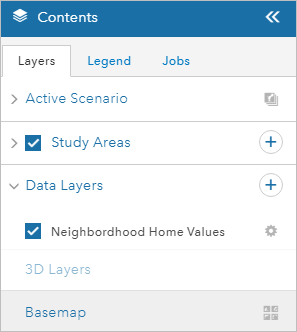
The Active Scenario category contains the design layers. Design layers are the layers in which you can sketch, paint, and split features. Each GeoPlanner project has one or more design layers that are defined in a template. You can add new layers to an existing set of design layers in a project using the Add to Design Layers tool.
The Layers group contains layers that are used for visualization and analysis. Some layers can also be used in the dashboard. You add layers using the Add Data tool on the Explore toolbar.
Basemap displays the name of the active basemap. Click the Change Basemap tool to switch to another basemap.
Clicking the gear icon next to a layer in the Layers pane of the Contents window displays a context menu.
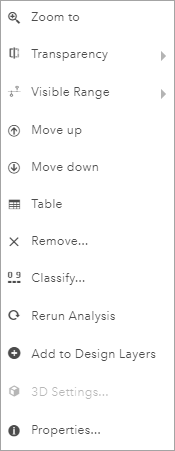
The menu lists layer-related functionality in GeoPlanner. Functions include the following:
- Zoom to—Sets the map extent to the extent of the selected layer.
- Transparency—Sets the transparency level of the selected layer.
- Visible Range—Specify at what zoom levels content is drawn in a layer.
Tip:
When a layer is out of range, its name appears in a lighter gray color in the contents and legend than the layers that are in range.
- Move up—Moves the selected layer one level up in the table of contents and the map.
- Move down—Moves the selected layer one level down in the table of contents and the map.
- Table—An interactive table that allows you to see a tabular view of the information about features in a layer.
Once the table is open in the map, you can view the layer's attributes. Click the Options button
 to manipulate the table in the following ways:
to manipulate the table in the following ways:- Default sort order
- Clear selection
- Show/Hide columns
Note:
Tables are only available with feature layers.
- Remove—Removes a layer from the table of contents and the map.
- Classify—Creates an assessment or suitability layer by reclassifying data into a 0–9 scale based on attributes. You can use this layer as an assessment layer in the secondary chart of the dashboard.
- Rerun Analysis—Will open the tool that was used to create the layer and repopulate all of the parameters.
- Add to Design Layers—Adds the layer to the Active Scenario group so you can sketch and paint using the types defined in the layer. This option only displays for feature layers.
- Properties—Opens the Layer Properties window for the selected layer.
- Design Types—Allows you to change a design layer's symbology, type names, and default values. This option only displays for layers in the Active Scenario area. You can add a new design type to a layer or delete an existing type.
- Duplicate Design Layer—Makes a copy of the design layer. This option only displays for layers in the Active Scenario area.
- Rename Design Layer—Renames a design layer from its context menu.
- Delete Design Layer—Deletes the design layer from your project. This option only displays for layers in the Active Scenario area.
- Modeler—Opens the weighted overlay model for a weighted overlay model layer. This option only displays for weighted overlay model layers.
The following sections detail how you can use some of these functions.
Remove a layer from a project
GeoPlanner allows you to remove certain types of layers from the map. Basemap layers cannot be removed from your project; however, you can remove other layer types. These layers include scenario layers, analysis results, operational layers, weighted overlay model layers, and other layers added directly from your organization. Use the following process to remove a layer from your project.
- Click the Contents button to open the Contents window.
- In the Layers pane, click the gear icon next to a layer name and click Remove.
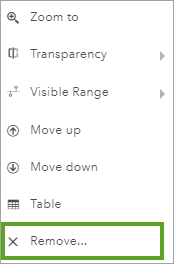
Change the order of layers in a map
You can set the order of certain types of layers in the map. Scenario layers are always displayed on top of other layers and cannot be moved down. Basemap layers are always displayed below other layers and cannot be moved up. Other layers, such as analysis result layers, operational layers, and other layers added directly from your organization can be moved up or down. The Move up and Move down functions are available in the menu in the Layers pane.
- Click Contents.
- In the Layers pane, click the gear icon to the right of the layer name and choose Move up or Move down.
Depending on the layer type and the order of the layer in the map, the Move up or Move down function may be hidden or unavailable. For scenario layers and basemap layers, these two functions are not available. Feature layers are always displayed on top of image and map layers and basemaps. For example, if you have one map layer and three feature layers, you can reorder the feature layers, but you cannot move the map layer on top of them.
- Click Save Map to save your changes to the project map.
Add to design layers
Each GeoPlanner project is created from a template. Templates are a group, a web map, and a hosted feature service that contains one or more feature layers. Feature layers contain types and default values for each type.
You may find that the types and default values are not applicable for your planning domain and project. GeoPlanner allows you to append your own layers as design layers. This will help you plan and sketch using the symbols and types that are specific to your planning domain. The following steps describe how to add an existing layer as a new design layer:
- Add a layer to GeoPlanner.
For that layer to be useful in GeoPlanner as a design layer, it should have types. If it does not have types, it should have a unique value renderer.
- Click the settings icon next to the layer in the Contents pane. Choose Add to Design Layers from the menu.
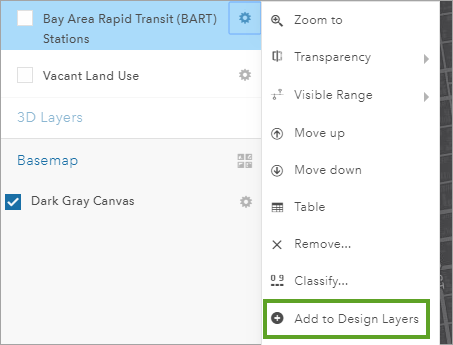
- On the Add to Design Layers dialog box, type a new name for your design layer in the New Name field.
- Optionally check Import features to import both schema and data into your new design layer.
- Click Import.
The Add to Design Layers dialog box closes and the project re–initializes. When re–initialization completes, a new design layer appears in the Active Scenario group.
Change design layer symbols, type labels, and default values
Layers have types. Types can represent different entities such as land use or zoning. You can change the symbols, labels, and default values of types in a design layer.
- Click the settings icon next to a design layer in the Active Scenario area of the Contents pane, and choose Design Types from the menu.
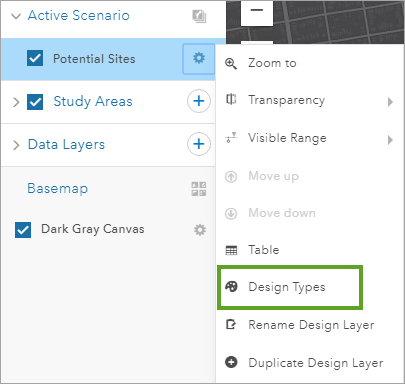
- In the design type editor dialog box, click a type in the list on the left side and perform one of the following actions:
- Click the symbol tab to make changes to a symbol's color and outline.
- Click the type tab to change a type's label.
- Click the default values tab to change a type's default values.
Note:
You can add a new design type to a layer or delete an existing type by clicking the Add or Delete button at the top left. - Click Save to save your changes and re–initialize your project.
Define a study area
In a GeoPlanner project, a study area defines a planning subarea. A planning subarea can represent a neighborhood, habitat, or any other location type. Once you enable a study area, GeoPlanner focuses its indicators, import operations, and visual review on that area. An enabled study area displays a mask that obscures everything outside the study area. The dashboard will only report on features that intersect or lie within an activated study area. The Import Scenario tool will only import features that intersect or lie within an enabled study area.
Follow these steps to define a study area:
- Open the Contents pane by clicking the Contents button
 .
. - Click the Layers tab, hover over the plus (+) icon and click Add Study Area.
- On the New Study Area dialog box, click Draw an area on the map.
- Click Polygon and draw one or more polygons on the map to define your study area.
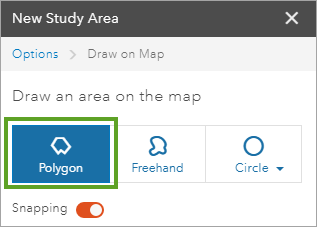
- Type a name for your study area and click Save.
Note:
You can also create a study area from an existing feature by clicking the Import link in a pop-up window.